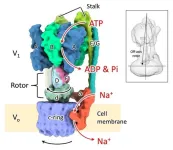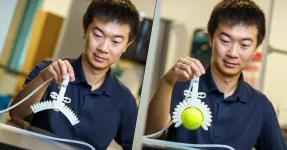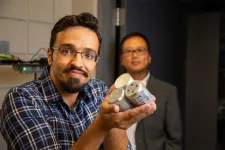(Press-News.org) North Carolina State University researchers recently found that a program designed to get Girl Scouts involved in citizen science – programs where members of the public can participate in real scientific research – not only taught girls about the process of science, but also motivated them to tackle scientific or environmental problems in their communities.
The findings demonstrate the impacts citizen science projects can have on their participants and offer lessons for other organizations on how to structure STEM-focused learning opportunities using citizen science.
“We’ve found that after participating in citizen science, students do not just learn more science content or the process of science, or have better attitudes or trust in science,” said study co-author Caren Cooper, professor of public science at NC State. “It can be the basis for motivating action.”
The study evaluated the impact of a partnership between the Girl Scouts of the USA and SciStarter.org, an online hub for citizen science projects. Between 2017 and early 2020, more than 200 Girl Scout troops with girls between the ages of 4 and 11 participated in a program called “Think Like a Citizen Scientist.”
First, the Girl Scouts learned about making observations or predictions, collecting data and doing data analysis. Then, they signed up to participate in a citizen science project through SciStarter. The most popular project was one led by applied ecology researchers at NC State called “Ant Picnic,” where volunteers created a picnic for ants, waited an hour and recorded the number of ants that showed up.
“These citizen science projects were chosen by Girl Scouts and SciStarter to be age-appropriate, and were part of a multi-stage curriculum, or ‘journey,’ designed to introduce girls to citizen science,” said the study’s lead author, Haley Smith, a Ph.D. candidate in NC State’s Fisheries, Wildlife, and Conservation Biology program. “The Girl Scouts’ program design is a really great model, where learning activities are structured to build off of each other. Girls gain more independence as they go along. That’s something other organizations could use to set up participants in citizen science projects for success.”
After participating in the citizen science projects, the Girl Scouts completed “Take Action Projects” in their communities. These projects included activities such as installing recycling bins; educating family members about water pollution; creating gardens at a YMCA to attract native insects; raising money to buy science books for the local library; and even sewing sleeping bags for a hedgehog at a nature center. Most girls (81%) chose projects addressing science or environmental topics, and many of the projects (66%) were designed to educate or inspire others.
“In the overwhelming majority of cases, we saw girls taking what they had done with citizen science and extending that in some way, such as by supporting science literacy, promoting environmental goals like recycling, or providing habitat,” Smith said.
Girl Scout troop leaders reported in surveys that girls who completed the program learned about science and environmental topics and about the process of science, developed confidence in STEM, and received other benefits. Most importantly, they learned to identify and address problems in their communities.
“Because of this research, we now have empirical qualitative data that reinforces the crucial role of organizations like the Girl Scouts in facilitating participation in citizen science, and therefore in expanding awareness of, access to, and engagement in science and related local actions,” said Darlene Cavalier, co-author and founder of SciStarter.
The study, “Facilitator organizations enhance learning and action through citizen science: a case study of Girl Scouts’ Think Like a Citizen Scientist journey on SciStarter,” was published online July 26 in the journal Environmental Education Research. Co-authors included K.C. Busch, Suzanne Harper, Amy Muslim, Kaleigh McKenna and Darlene Cavalier. The National Science Foundation AISL award #1713562 supported Smith and Cooper in the work.
-oleniacz-
Note to Editors: The study abstract follows.
Facilitator organizations enhance learning and action through citizen science: a case study of Girl Scouts’ Thank Like a Citizen Scientist journey on SciStarter
Authors: Haley E. Smith, Caren B. Cooper, K.C. Busch, Suzanne Harper, Amy Muslim, Kaleigh McKenna and Darlene Cavalier
Published: July 26, Environmental Education Research
DOI: 10.1080/13504622.2023.2237705
Abstract: Engagement in citizen science can result in participant outcomes including increased science and environmental literacy and civic action. One factor which may increase the likelihood of these outcomes is facilitation by groups such as employers, schools, or other organizations. We examined how a partnership between SciStarter and Girl Scouts of the USA facilitated participation in citizen science to shape participants’ learning and civic engagement. Between July 2017 and February 2020, participants from over 200 Girl Scout troops completed the Think Like a Citizen Scientist Journey, consisting of science learning activities, participation in an environmental citizen science project on SciStarter, and a Take Action Project (TAP). Troop leaders provided open-ended descriptions of TAPs which we analyzed qualitatively. Responses provided evidence of learning outcomes spanning informal science learning goals, Girl Scout Leadership Experience outcomes, and Girl Scout STEM outcomes. Participants’ TAPs overwhelmingly related to science and environmental topics (81%) and the majority sought to educate and inspire others (66%), reaching audiences of peers, adults, the general public, and civic leaders. This program demonstrates the potential for facilitator organizations to leverage existing citizen science projects to promote learning outcomes, civic science education, and community action with participants as young as 4–5 years old.
END
Six structures exhibited by the rotating sodium ion pump were reconstructed in 3D using cryo-electron microscopy. This analysis revealed that (1) the rotor exhibits non-uniform rotation behavior due to partial structural interference with the stator component, and (2) the rotor interacts with one edge of the large ion transport ring causing it to rotate. The study showed a unique molecular mechanism of the rotary sodium ion pump.
The results will be published on July 28 in Communications Biology.
“In previous single-molecule imaging ...
Resilient corals, often referred to as ‘super corals’, have recently been seen as potential saviours in the face of climate change and its detrimental effects on coral reefs.
Now, a team of scientists from the University of Technology Sydney (UTS) and the University of Haifa, Israel is working to better understand these corals in order to develop strategies to protect fragile ecosystems such as the Great Barrier Reef.
UTS scientist Dr Emma Camp, co-lead researcher on the study recently published in the journal Nature Communications, says the findings have significant implications ...
Infants who nap a lot have smaller vocabularies and poorer cognitive skills – according to new research from the University of East Anglia.
Parents the world over are prone to worry about their children getting either too little or too much sleep.
But a new study published today reveals that some children are more efficient at consolidating information during sleep, so they nap less frequently.
Meanwhile others, usually those with fewer words and poorer cognitive skills, need to nap more frequently.
The research team say that reducing naps for these children will not improve brain development, ...
Though it’s just as likely to be worn while lounging on the couch as in the gym, a large driver of activewear’s popularity among women is its association with a dynamic lifestyle, positive wellbeing and overall good health.
However, two new Edith Cowan University (ECU) studies suggest online shopping for activewear may in fact be harmful to women’s body image.
Sales of “Athleisure” — a hybrid style of athletic clothing typically worn as everyday wear — have risen rapidly following ...
This soft robotic gripper is not only 3D printed in one print, it also doesn’t need any electronics to work.
The device was developed by a team of roboticists at the University of California San Diego, in collaboration with researchers at the BASF corporation, who detailed their work in a recent issue of Science Robotics.
The researchers wanted to design a soft gripper that would be ready to use right as it comes off the 3D printer, equipped with built in gravity and touch sensors. As a result, the gripper can pick up, hold, and release objects. No such gripper existed before this work.
“We ...
Opioids remain the most potent and effective pain relievers in medicine, but they’re also among the most addictive drugs that can halt a person’s ability to breathe during an overdose — which can be deadly. Researchers have been racing to develop safer pain reliever drugs that target a specific opioid receptor, called the kappa opioid receptor, that is only found in the central nervous system and not elsewhere in the body, like other opioid receptors. Previous research suggests that such drugs may not lead to addiction or death due to overdose, but ...
OVX836 demonstrated positive safety and immunogenicity data across three dose levels
A notable signal of protection of 84% was observed against symptomatic influenza infection
Lyon, France – July 28, 2023 – Osivax, a biopharmaceutical company developing vaccines to provide broad-spectrum protection against highly mutating infectious viruses, today announced that The Lancet Infectious Diseases published results from the company’s OVX836-003 study under the title, “Immunogenicity, safety and preliminary efficacy evaluation of OVX836, a nucleoprotein-based universal influenza A vaccine candidate: randomised, double-blind placebo-controlled, Phase 2a trial.” ...
A new Cochrane review finds that the use of physical restraints on care home residents can be reduced without increasing the risk of falls, when frontline care staff are empowered by supportive managers.
Physical restraints are devices that restrict freedom of movement and are frequently used in residential care homes, such as nursing homes and assisted living facilities. Examples are bed rails or belts that prevent residents from getting out of bed unassisted. These restraints are ethically problematic as they are mostly ...
July 27, 2023 – How many stars would you give your plastic surgeon? An analysis of Yelp reviews identifies a wide range of surgeon-and practice-related factors that influence whether plastic surgery patients leave positive or negative reviews, reports the September issue of Plastic and Reconstructive Surgery®, the official medical journal of the American Society of Plastic Surgeons (ASPS). The journal is published in the Lippincott portfolio by Wolters Kluwer.
"Our study also identifies some sources ...
Researchers at the FAMU-FSU College of Engineering are improving the safety and performance of electric vehicles through a new design that protects their batteries.
Their design uses tubes filled with paraffin wax, which is a type of phase change material, or PCM. These materials are commonly used to store and dissipate heat, making them useful for protecting a battery from overheating.
The researchers’ new method uses PCM-filled tubes in another way, exploring their application as protection against ...




